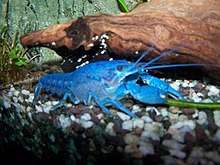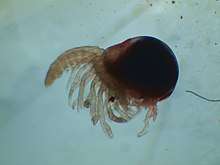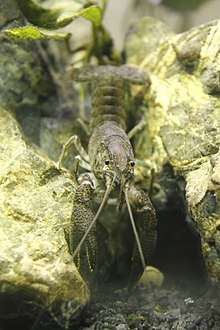Procambarus
Procambarus is a genus of crayfish in the family Cambaridae, all native to North and Central America. It includes a number of troglobitic species, and the marbled crayfish (marmorkrebs), which is parthenogenetic. Originally described as a subgenus for four species, it now contains 161 species in 16 subgenera.
| Procambarus | |
|---|---|
.jpg) | |
| Procambarus lagniappe | |
| Scientific classification | |
| Kingdom: | Animalia |
| Phylum: | Arthropoda |
| Subphylum: | Crustacea |
| Class: | Malacostraca |
| Order: | Decapoda |
| Family: | Cambaridae |
| Genus: | Procambarus Ortmann, 1905 [1] |
| Type species | |
| Procambarus digueti Bouvier, 1897 | |
Biogeography
_(338603856).jpg)

The majority of the diversity is found in the southeastern United States, but the genus extends as far south as Guatemala and Honduras, and on the Caribbean island of Cuba.[2][3] After United States, the highest diversity is in Mexico with about 45 species. Only two are native to Guatemala (P. pilosimanus and P. williamsoni), one to Belize (P. pilosimanus), one to Honduras (P. williamsoni) and three to Cuba (P. atkinsoni, P. cubensis and P. niveus).[3]
Subgenus Ortmannicus is the most widespread, with the range of Procambarus acutus extending as far north as the Great Lakes and New England, as well as south into northeastern Mexico; the subgenus Girardella also extends from the Great Lakes to Mexico, but is distributed further west than Ortmannicus.[4] Scapulicambarus and Pennides are widespread in the southeastern United States, where Remoticambarus also lives, further west (Texas and Louisiana) than Leconticambarus which is centered on Florida and neighboring states. The subgenus Austrocambarus has the most southerly distribution, being found in Cuba and parts of Central America from Mexico to Belize, Guatemala and Honduras. The other subgenera are more restricted in their distributions, including three endemic to central Mexico, and six endemic to small areas in the United States.[2][3][4]
A few species of Procambarus have been introduced to regions outside their native range, both in North America and other continents. They are frequently categorized as invasive species, representing a threat to natives, including rarer crayfish species.[3][5][6]
Description

Procambarus can be distinguished from other genera of crayfish by the form of the first pleopod in males, which typically has three or more processes at the tip, compared to two or fewer in Orconectes and Cambarus.[7]
Ecology

Most Procambarus species live in various above-ground waters such as rivers, streams, lakes, ponds and swamps, but several are troglobitic, living in caves, particularly in karstic areas. In the United States, these include both species in subgenus Lonnbergius (P. acherontis and P. morrisi) and the single species in the subgenus Remoticambarus, P. pecki.[8] Other cave-dwellers in the United States with various levels of troglomorphic adaptions are P. attiguus, P. erythrops, P. franzi, P. leitheuseri, P. lucifugus, P. milleri and P. orcinus, but these are all members of subgenera that also include species from above-ground waters. In Cuba, P. niveus is a cave-dweller. In Mexico, many species have been recorded in caves, but most of these have also been recorded from above-ground waters; only P. cavernicola, P. oaxacae, P. rodriguezi and P. xilitlae are strict cave-dwellers and troglomorphic.[9]
Taxonomy
Procambarus was originally described by Arnold Edward Ortmann in 1905 as a subgenus of a wider genus Cambarus, and originally contained only four species (P. williamsoni, P. diguieti, P. mexicanus and P. cubensis).[10] The subgenus was elevated in 1942 to the taxonomic rank of genus by Horton H. Hobbs, Jr., who later erected most of the subgenera now recognised within the genus, in his 1972 monograph The subgenera of the crayfish genus Procambarus (Decapoda: Astacidae).[4]
Subgenera and species
- Acucauda Hobbs, 1972
- Procambarus fitzpatricki Hobbs, 1972
- Austrocambarus Hobbs, 1972
- Procambarus acanthophorus Villalobos, 1948
- Procambarus atkinsoni (Ortmann, 1913)
- Procambarus catemacoensis Rojas, Alvarez & Villalobos, 2000
- Procambarus citlaltepetl Rojas, Alvarez & Villalobos, 1999
- Procambarus cubensis (Erichson, 1846)
- Procambarus llamasi Villalobos, 1954
- Procambarus mexicanus (Erichson, 1846)
- Procambarus mirandai Villalobos, 1954
- Procambarus niveus Hobbs & Villalobos, 1964
- Procambarus oaxacae Hobbs, 1973
- Procambarus olmecorum Hobbs, 1987
- Procambarus pilosimanus (Ortmann, 1906)
- Procambarus primaevus (Packard, 1880)
- Procambarus rodriguezi Hobbs, 1943
- Procambarus ruthveni Pearse, 1911
- Procambarus sbordonii Hobbs, 1977
- Procambarus vazquezae Villalobos, 1954 (species name often misspelled vasquezae)
- Procambarus veracruzanus Villalobos, 1954
- Procambarus williamsoni (Ortmann, 1905)
- Procambarus zapoapensis Villalobos, 1954
- Capillicambarus Hobbs, 1972
- Procambarus brazoriensis Albaugh, 1975
- Procambarus hinei (Ortmann, 1905)
- Procambarus incilis Pennington, 1962
- Girardiella Lyle, 1938
- Procambarus barbiger Fitzpatrick, 1978
- Procambarus ceruleus Fitzpatrick & Wicksten, 1998
- Procambarus cometes Fitzpatrick, 1978
- Procambarus connus Fitzpatrick, 1978
- Procambarus curdi Reimer, 1975
- Procambarus ferrugineus Hobbs & Robison, 1988
- Procambarus gracilis (Bundy, 1876)
- Procambarus hagenianus (Faxon, 1884)
- Procambarus kensleyi Hobbs, Jr., 1990
- Procambarus liberorum Fitzpatrick, 1978
- Procambarus nigrocinctus Hobbs, Jr., 1990
- Procambarus parasimulans Hobbs & Robison, 1982
- Procambarus pogum Fitzpatrick, 1978
- Procambarus regalis Hobbs & Robison, 1988
- Procambarus regiomontanus Villalobos, 1954
- Procambarus reimeri Hobbs, 1979
- Procambarus simulans (Faxon, 1884)
- Procambarus steigmani Hobbs, Jr., 1991
- Procambarus tulanei Penn, 1953
- Hagenides Hobbs, 1972
- Procambarus advena (LeConte, 1856)
- Procambarus caritus Hobbs, 1981
- Procambarus geodytes Hobbs, 1942
- Procambarus pygmaeus Hobbs, 1942
- Procambarus rogersi (Hobbs, 1938)
- Procambarus talpoides Hobbs, 1981
- Procambarus truculentus Hobbs, 1954
- Leconticambarus Hobbs, 1972
- Procambarus alleni (Faxon, 1884)
- Procambarus apalachicolae Hobbs, 1942
- Procambarus barbatus (Faxon, 1890)
- Procambarus capillatus Hobbs, 1971
- Procambarus econfinae Hobbs, 1942
- Procambarus escambiensis Hobbs, 1942
- Procambarus hubbelli (Hobbs, 1940)
- Procambarus kilbyi (Hobbs, 1940)
- Procambarus latipleurum Hobbs, 1942
- Procambarus milleri Hobbs, 1971
- Procambarus pubischelae Hobbs, 1942
- Procambarus rathbunae (Hobbs, 1940)
- Procambarus shermani Hobbs, 1942
- Lonnbergius Hobbs, 1972
- Procambarus acherontis (Lönnberg, 1894)
- Procambarus morrisi Hobbs, Jr. & Franz, 1991
- Mexicambarus Hobbs, 1972
- Procambarus bouvieri (Ortmann, 1909)
- Ortmannicus Fowler, 1912
- Procambarus acutissimus (Girard, 1852)
- Procambarus acutus (Girard, 1852)
- Procambarus ancylus Hobbs, 1958
- Procambarus angustatus (LeConte, 1856)
- Procambarus attiguus Hobbs, Jr. & Franz, 1992
- Procambarus bivittatus Hobbs, 1942
- Procambarus blandingii (Harlan, 1830)
- Procambarus braswelli J. E. Cooper, 1998
- Procambarus caballeroi Villalobos, 1944
- Procambarus chacei Hobbs, 1958
- Procambarus delicatus Hobbs & Franz, 1986
- Procambarus enoplosternum Hobbs, 1947
- Procambarus epicyrtus Hobbs, 1958
- Procambarus erythrops Relyea & Sutton, 1975
- Procambarus evermanni (Faxon, 1890)
- Procambarus fallax (Hagen, 1870)
- Procambarus fallax form virginalis (Hagen, 1870) a.k.a. Marmorkrebs
- Procambarus franzi Hobbs & Lee, 1976
- Procambarus geminus Hobbs, 1975
- Procambarus gonopodocristatus Villalobos, 1958
- Procambarus hayi (Faxon, 1884)
- Procambarus hirsutus Hobbs, 1958
- Procambarus horsti Hobbs & Means, 1972
- Procambarus hybus Hobbs & Walton, 1957
- Procambarus jaculus Hobbs & Walton, 1957
- Procambarus lecontei (Hagen, 1870)
- Procambarus leitheuseri Franz & Hobbs, 1983
- Procambarus leonensis Hobbs, 1942
- Procambarus lepidodactylus Hobbs, 1947
- Procambarus lewisi Hobbs & Walton, 1959
- Procambarus litosternum Hobbs, 1947
- Procambarus lophotus Hobbs & Walton, 1960
- Procambarus lucifugus (Hobbs, 1940)
- Procambarus lunzi (Hobbs, 1940)
- Procambarus mancus Hobbs & Walton, 1957
- Procambarus marthae Hobbs, 1975
- Procambarus medialis Hobbs, 1975
- Procambarus nechesae Hobbs, Jr., 1990
- Procambarus nueces Hobbs, Jr. & Hobbs III, 1995
- Procambarus orcinus Hobbs & Means, 1972
- Procambarus pallidus (Hobbs, 1940)
- Procambarus pearsei (Creaser, 1934)
- Procambarus pictus (Hobbs, 1940)
- Procambarus planirostris Penn, 1953
- Procambarus plumimanus Hobbs & Walton, 1958
- Procambarus pubescens (Faxon, 1884)
- Procambarus pycnogonopodus Hobbs, 1942
- Procambarus seminolae Hobbs, 1942
- Procambarus texanus Hobbs, 1971
- Procambarus toltecae Hobbs, 1943
- Procambarus verrucosus Hobbs, 1952
- Procambarus viaeviridis (Faxon, 1914)
- Procambarus villalobosi Hobbs, 1969
- Procambarus xilitlae Hobbs & Grubbs, 1982
- Procambarus youngi Hobbs, 1942
- Procambarus zonangulus Hobbs, Jr. & Hobbs III, 1990
- Paracambarus Ortmann, 1906
- Procambarus ortmannii Villalobos, 1949
- Procambarus paradoxus (Ortmann, 1906)
- Pennides Hobbs, 1972
- Procambarus ablusus Penn, 1963
- Procambarus clemmeri Hobbs, 1975
- Procambarus dupratzi Penn, 1953
- Procambarus echinatus Hobbs, 1956
- Procambarus elegans Hobbs, 1969
- Procambarus gibbus Hobbs, 1969
- Procambarus lagniappe Black, 1968
- Procambarus lylei Fitzpatrick & Hobbs, 1971
- Procambarus natchitochae Penn, 1953
- Procambarus ouachitae Penn, 1956
- Procambarus pentastylus Walls & Black, 2008
- Procambarus penni Hobbs, 1951
- Procambarus petersi Hobbs, 1981
- Procambarus raneyi Hobbs, 1953
- Procambarus roberti Villalobos & Hobbs, 1974
- Procambarus spiculifer (LeConte, 1856)
- Procambarus suttkusi Hobbs, 1953
- Procambarus versutus (Hagen, 1870)
- Procambarus vioscai Penn, 1946
- Procambarus Ortmann, 1905
- Procambarus digueti (Bouvier, 1897)
- Remoticambarus Hobbs, 1972
- Procambarus pecki Hobbs, 1967
- Scapulicambarus Hobbs, 1972
- Procambarus clarkii (Girard, 1852)
- Procambarus howellae Hobbs, 1952
- Procambarus okaloosae Hobbs, 1942
- Procambarus paeninsulanus (Faxon, 1914)
- Procambarus strenthi Hobbs, 1977
- Procambarus troglodytes (LeConte, 1856)
- Tenuicambarus Hobbs, 1972
- Procambarus tenuis Hobbs, 1950
- Villalobosus Hobbs, 1972
- Procambarus contrerasi (Creaser, 1931)
- Procambarus cuetzalanae Hobbs, 1982
- Procambarus erichsoni Villalobos, 1950
- Procambarus hoffmanni (Villalobos, 1944)
- Procambarus hortonhobbsi Villalobos, 1950
- Procambarus riojai (Villalobos, 1944)
- Procambarus teziutlanensis (Villalobos, 1947)
- Procambarus tlapacoyanensis (Villalobos, 1947)
- Procambarus xochitlanae Hobbs, 1975
- Procambarus zihuateutlensis Villalobos, 1950
References
- "Procambarus Ortmann, 1905". Integrated Taxonomic Information System. Retrieved June 14, 2011.
- Horton H. Hobbs, Jr. (1984). "On the distribution of the crayfish genus Procambarus (Decapoda: Cambaridae)". Journal of Crustacean Biology. 4 (1): 12–24. doi:10.2307/1547892. JSTOR 1547892.
- Alvarez. F.; J.L. Villalobos (2015). "The Crayfish of Middle America". In T. Kawai; Z. Faulkes; G. Scholtz (eds.). Freshwater Crayfish: A Global Overview. CRC Press. pp. 448–463. ISBN 9781466586390.
- Horton H. Hobbs, Jr. (1972). "The subgenera of the crayfish genus Procambarus (Decapoda: Astacidae)" (PDF). Smithsonian Contributions to Zoology. 117: 1–22.
- D. M. Holdich; J. D. Reynolds; C. Souty-Grosset; P. J. Sibley (2009). "A review of the ever increasing threat to European crayfish from non-indigenous crayfish species". Knowledge and Management of Aquatic Ecosystems. 394–395 (394–395): 11. doi:10.1051/kmae/2009025.
- J. P. G. Jones; J. R. Rasamy; A. Harvey; A. Toon; B. Oidtmann; M. H. Randrianarison; N. Raminosoa; O. R. Ravoahangimalala (2009). "The perfect invader: A parthenogenic crayfish poses a new threat to Madagascar's freshwater biodiversity". Biological Invasions. 11 (1): 1475–1482. doi:10.1007/s10530-008-9334-y.
- Richard Fox (June 27, 2006). "Procambarus". Invertebrate Anatomy OnLine. Lander University. Archived from the original on January 17, 2012. Retrieved March 28, 2010.
- James W. Fetzner, Jr. (January 11, 2006). "Troglobitic crayfishes". Global Crayfish Resources. Carnegie Museum of Natural History. Archived from the original on March 4, 2016. Retrieved June 14, 2011.
- Mejía-Ortíz, L.M.; R.G. Hartnoll; J.A. Viccon-Pale (2003). "A New Stygobitic Crayfish from Mexico, Procambarus Cavernicola (Decapoda: Cambaridae), with a Review of Cave-Dwelling Crayfishes in Mexico". Journal of Crustacean Biology. 23 (2): 391–401. doi:10.1163/20021975-99990349.
- Arnold Edward Ortmann (1905). "Procambarus, a new subgenus of the genus Cambarus". Annals of the Carnegie Museum. 3 (3).
External links


- Key to the subgenera of Procambarus